1. Overview
Difficult-to-machine materials such as high-chromium cast iron, wear-resistant alloy cast iron, and chilled cast iron have been widely used in industries such as electric power, metallurgy, coal, and Jianbang. High-chromium white cast iron is a material that is often used. This material belongs to high-alloy cast iron, and the casting has good wear resistance and high hardness. The cutting temperature is also high, coupled with the plastic deformation of the tool, it is easy to cause the tool to break.
In the metal cutting of the above industries, the following problems have been faced for a long time: cemented carbide inserts can only withstand low cutting speeds, and cannot process castings above 58HRC; ceramic inserts can withstand cutting speeds of about 10m/min in rough turning , but when encountering slag inclusions, trachoma or intermittent turning such as the impeller of the slurry pump, the phenomenon of blade fragmentation often occurs, the wear, damage, and chipping of the blade are very serious, and the cutting efficiency is extremely low. People have been looking for more suitable tools, and the development and application of the new overall polycrystalline cubic boron nitride (PCBN) tool BN-K1 can solve these bottleneck problems well.
With the development of cubic boron nitride (CBN) nanotechnology and the innovation of synthesis technology, it has become a reality to use CBN tool BN-K1 material to process high chromium cast iron/white cast iron. Compared with ceramic knives, BN-K1 material PCBN knives have higher hardness, wear resistance, impact strength and crush resistance. The main synthesis types of PCBN insert materials include poly wafer (insert synthesized by CBN and bonding agent) and composite sheet (composite CBN insert with cemented carbide as the matrix). A large number of facts show that the BN-K1 material made of polycrystalline cubic boron nitride is an ideal tool for high-efficiency and high-quality machining of cast iron and hard steel (above 45HRC).
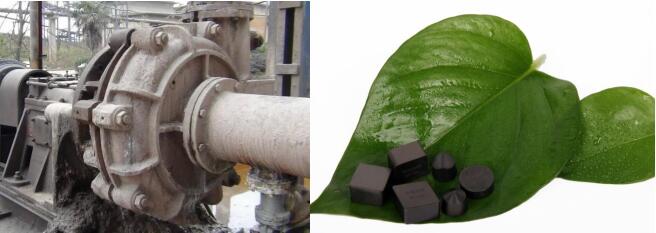
2. Comparison of cutting performance between solid PCBN tools and ceramic tools
2.1 Selection of tool structure and cutting parameters
The overall PCBN tool BN-K1 material and the silicon nitride ceramic tool are used to dry turn the slurry pump sheath respectively. The size of the tool holder used is: 150mm×30mm×35mm.
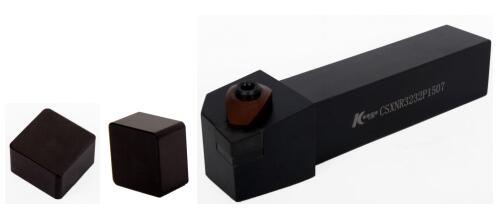
2.2 Cutting phenomenon
When turning Cr26 with PCBN tool BN-K1 grade, the chips were chipped at the beginning, and after 10 to 15 minutes, the insert was slightly worn, and the chips began to elongate. At the same time, the color of the chips changed from golden yellow to light blue or dark blue. The color, the process of the blade processing the workpiece is transformed from pure cutting to the coexistence of cutting and extrusion, which is different from the pure extrusion phenomenon of ceramic tools.
When processing PCBN tool BN-K1 grade, the sound is crisp and clear, without the harsh noise of ceramic tool processing. There is no obvious gap in the flank of the PCBN tool, but there is a gap in the flank of the ceramic tool, and it expands quickly. The surface roughness value of PCBN tool processing is consistent, while the surface roughness value of ceramic tool processing increases with the increase of processing time.
Figure 1 shows the flank wear (VB) of PCBN tools and silicon nitride ceramic tools when cutting Cr26. It can be seen from the figure that the cutting performance of PCBN tools is better than that of Si3N4 ceramic tools. When cutting Cr26 at high speed, the wear resistance of PCBN tools is 25 times that of silicon nitride ceramics, the impact resistance is more than 2000 times that of silicon nitride ceramics, and the tool life can reach 22 to 30 times that of silicon nitride ceramics.
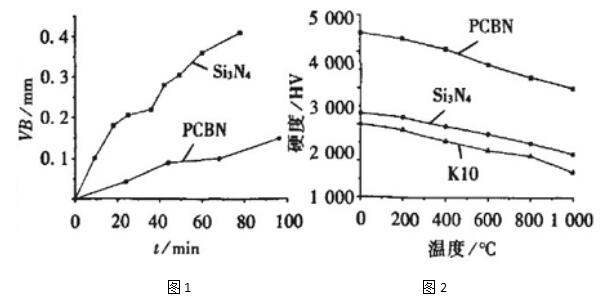
2.3 Comparative Analysis of insert Performance
Compared with ceramic blades, the overall PCBN blade BN-K1 material has many advantages. First of all, its hardness is high, generally around 3500HV, which is twice that of ceramic blades and four times that of alloy blades. The heat resistance of CBN can reach 1400-1500°C, and the hardness of PCBN at 1000°C is higher than that of ceramics and hard alloys at room temperature, as shown in Figure 2.
Therefore, PCBN tool BN-K1 material can cut superalloy and hardened steel at a speed 3 to 5 times higher than that of cemented carbide tool, which also creates conditions for high-speed cutting of PCBN tool BN-K1 material.
Secondly, the BN-K1 material has good wear resistance. Cubic boron nitride is a non-metallic boride. The crystal structure belongs to the cubic crystal system. Nitrogen and boron atoms are covalently bonded to form a saturated structure of four pairs with each other. The PCBN sintered body formed at high temperature contains nitrides, borides, and oxides. These superhard mixtures are combined with strong covalent bonds, have very low standard free energy, and form a very stable system. Therefore, the overall PCBN blade BN-K1 The hardness of the material will not decrease at high temperature.
In addition, the strength is high, and the fracture toughness KIC value of CBN is higher than that of ceramics, and the KIC of some grades is even close to cemented carbide. For brittle tool materials, the wear mechanism is brittle fracture. Grain boundary fracture will occur on the worn surface, and some grains will be partially broken. At this time, the wear resistance depends on the KIC value of the material. The larger the KIC value, the less likely it is to break. When rough turning cast parts, due to the large amount of cutting, in order to improve efficiency, the depth of cutting must be increased. The main cutting force FZ=2000fap, if the cutting depth ap is increased, the cutting force FZ will inevitably be increased, which requires the tool to have higher strength; compared with ceramic tools, the overall PCBN tool is more suitable for high-speed cutting with large depth of cut.
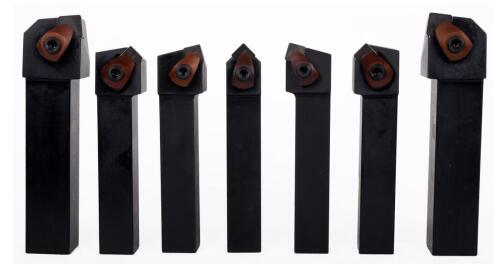
3. Application solutions
3.1 Solid PCBN insert intermittently turning the outer circle of slurry pump impeller
Use the solid CBN tool BN-K1 grade to turn the outer circle of the impeller of the slurry pump. Since the impeller has 5 blades, it is cut intermittently. The cutting parameters of HLCBN tools are: vc=75m/min, ap=5mm, f=0.1mm/r. During the cutting process, the tool has to withstand 5 impacts per revolution of the impeller, and each cutting edge has to withstand more than 3,000 impacts. The cutting results show that the HLCBN tool does not break after cutting a workpiece, and one blade is equivalent to 25 ceramic blades, which fully demonstrates its heat resistance and impact resistance performance, which not only greatly reduces the cost of the tool, but also improves the production efficiency 5 times.
3.2 Inner hole of the impeller with solid PCBN tool finish turning
BN-K1 round inserts are used to finish the inner hole, the hole depth is 80mm, and the cutting parameters are: vc=100m/min, ap=1mm, f=0.5mm/r. The inner hole is completed in one finish turning, and the measured dimensions at both ends are the same, and there is no retraction phenomenon. The solid CBN has good wear resistance, and the size consistency of the processed parts is guaranteed; while the fine turning of ceramic tools requires 3 to 4 passes to complete, and the blade edge wears faster during cutting, resulting in increased cutting resistance, resulting in tool retraction, serious affect the quality of the machined surface. Cutting tools for machining high chromium cast iron
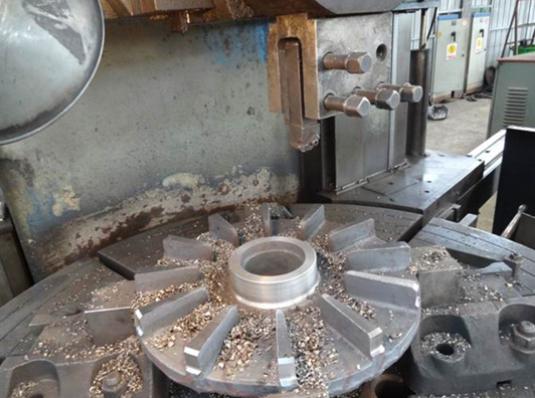
4. Conclusion
1) Aiming at the problems in the high-speed cutting of the slurry pump made of BN-K1 material by the solid CBN tool, some cutting parameters, and experience in use are summarized. Available roughing parameters in practice: vc=65~90m/min, ap=5~10mm, f=0.12~0.18mm/r; finishing parameters: vc=80~120m/min, ap≤5mm, f= 0.2~0.3mm/r. When the hardness of the processed material is high, the rigidity of the machine tool is poor, and the intermittent cutting is serious, within the above cutting parameter range, lower processing parameters can be selected to prolong the tool life.
2) The solid CBN tool BN-K1 has high hardness, good wear resistance, and is not easy to break. It is more suitable for intermittent cutting of high hardness and high wear resistance materials.
3) Compared with ceramic tools, the solid CBN tool BN-K1 material can adopt high cutting speed to achieve real high-speed cutting.
4) The application of the BN-K1 material of the overall PCBN tool not only improves the processing quality of the product, but also greatly improves the production efficiency, which meets the needs of high-quality and efficient production in modern industry, and has a good promotion value.